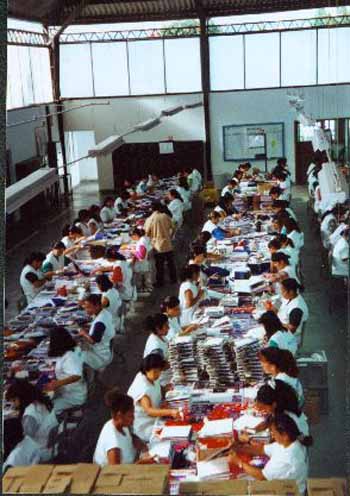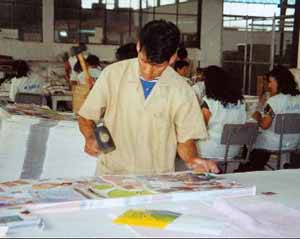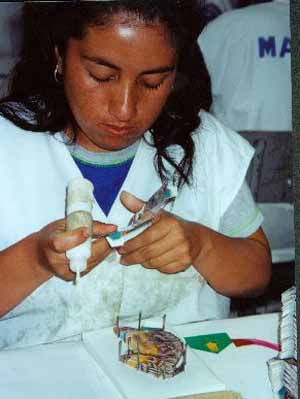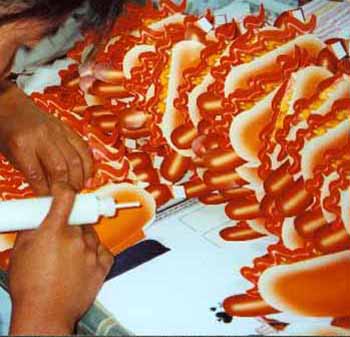MY TRIP TO MECCA
Seeing Pop-ups Made
by Ellen G.K. Rubin
(reprinted from Movable Stationery vol.8 no.3 August 2000)
No less compelling than the holy city of Mecca, Ibarra, Ecuador is the pop-up collector’s center of the Universe. Imagine my demeanor of reverence layered over the giddiness of good fortune at having to go to Cargraphics, S.A. in Ibarra to witness the production of Brooklyn Pops Up, the pop-up catalog for the forthcoming exhibition, Brooklyn Pops Up! The History and Art of the Movable Book – see photos. (The issue of the disappearing exclamation point will not be addressed here.) As on any first time pilgrimage, one must have an experienced guide. Mine was none other than Robert Sabuda, designer of the catalog, a contributing paper engineer, and co-curator of the exhibition along with Ann Montanaro and myself. Over twelve years of collecting and writing about pop-ups had led to my having a part in making one.
Now we were off to the real thing, the dreams and plans of two years behind us. The catalog would have eight spreads each depicting a Brooklyn landmark which satisfied the Library’s challenge to make the exhibition relevant to Brooklyn. Twelve paper engineers and illustrators from around the world were enthusiastically contributing their expertise. Maurice Sendak, a Brooklyn native and a collector of pop-ups, was enlisted to do the cover art. Robert made the artwork movable with a peek-a-boo window on the reverse side, a la The Genius of Meggendorfer, the pop-up book celebrating Meggendorfer’s artistry.
The preliminary nesting sheets I had seen in New York were printed and die-cut in Cali, Colombia and trucked to Ibarra, 10 hours away. The 150 copies of the Limited Edition would be assembled and
numbered during our stay. Fifty of them were to have tipped-in sheets of signatures by the contributing artists. Robert had sent the sheets around the world. We were scheduled to meet our hosts from Cargraphics, Alvaro Lopez and Guillermo Holguin, for a week’s stay.
After driving through the lush green mountainous corridor from Quito (elev. 9,200 ft) to Ibarra, and congratulating ourselves on beating the usual high-altitude headache, we were greeted by a ‘Welcome to Ecuador’ sign over Cargraphic’s front door, a harbinger of the friendliness we encountered throughout our stay. I stepped through the portal atwitter with expectation. Here the very air felt different; everyone inside was concerned with the production of pop-up books. This visit was to be much like my Hanukkah trip to Israel. No longer in the Diaspora, I would be in a place which was singly centered on my interests, my passion.

Much like a sacred place, the interior of the Ibarra plant was awash in a great white light. The white walls of the factory were rimmed with windows at ceiling level on three sides letting in the sunlight filtered through the high thin air. Seated at over 15 long tables, in rows like pews, were almost 600 workers, mostly women, dressed in white coats. More than 200 were assigned to Brooklyn Pops Upalone and would produce the 16,500 book run in a week to ten days. Since there is no heavy machinery used in this facility, the quiet was broken only by the rustling of paper. In fact, the highest tech item I saw was an oscillating fan used to dry the glued stacks of completed spreads.
After being introduced to the supervisory staff and digging deeply into my limited Spanish-I had thumbed through my Berlitz book on the plane- we were ushered into the plant. Passing the on-site medical facility, we entered the scrapping room where die-cut pieces are separated. My heart jumped as it does when one recognizes a celebrity on the street. Lying on an entrance table were die-cut parts from Brooklyn Pops Up. These landmarks of New York were totally out of context. Here in the Andes, with a mix of Spanish and indigenous peoples, most of whom had never ventured beyond their village, lay the Brooklyn Bridge, Coney Island, and Nathan’s frankfurters. It was like finding a yo-yo in a Tibetan monastery. On shelves lay miniature boxes of Junior’s cheesecake and glasses of foamy egg creams for Moerbeek’s and Dijs’ Flavors of Brooklyn. The workers, with total indifference, used rubber mallets to pound out the shapes.

movables in Brooklyn Pops Up
Worker pounds out die-cut pieces for
movables in Brooklyn Pops Up
Like proud parents, Robert and I took photographs of our offspring (my first born!) from every vantage point. The workers smiled at our intensity of purpose and the dangerous positions we assumed as well. For them, this was just another book, another day’s work. But I was smiling beatifically. I was escorted from table to table by Alvaro whose business card boasts, Account Executive, Pop-up and Board Book Division. With more than 16 years of experience, he has devoted his working life to pop-ups. My kind of guy! In fact, what kept me grinning were the constant reminders that every person and artifact in the three assembly plants I visited were all devoted to pop-up books. Thinking of Robert’s oft quoted remark, “Pop-ups are the stepchildren of publishing,” I recalled feeling like an ignored stepchild myself. I know what it’s like to have my interest trivialized, relegated to the insubstantial. But here you could hear me humming the opening bars from “This Is My Country!”
Trekking through the plant, I saw workers at their tables with bowed heads and incessantly moving hands. Despite the surprising lack of conversation -handwork takes concentration- it was a relaxed atmosphere. At the end of each table was a yellow ‘happy face’ swaying slightly on a metal coil. If a row was having assembly problems, the ‘happy face’ was replaced with a frowning one to alert the line supervisor of a difficulty. There were few ‘frowns’ in the plant while I was there. I was told Cargraphics in Cali has a “Preliminary Studies” department which goes over the production of each book before the printed die-cuts leave for Ibarra. Many supervisors attributed the smooth work-flow to this innovative department.

One wall of the plant was lined with workshops and offices. The first large room was divided between a long table ringed with chairs and smaller tables where individual projects-now the Brooklyn Pops Up-Limited Edition– were going on. During my stay, the long table held new employees who were learning how to work on the assembly line. Sample projects were used to teach different assembly techniques. For example, a device called a rigging, a board of nails in the shape of a single die-cut, held each piece so that the assembler can glue another part in precisely the same place. In several other rooms doubling as offices, line supervisors sat at small round tables putting together individual spreads, working out the kinks. I marveled at them scurrying from office to office or office to assembly line holding different spreads from Brooklyn Pops Up, each spread making our plans a reality. I couldn’t help but laugh out loud watching the frankfurters being assembled; first, glue the two parts of the hot dog, then, glue it into the bun, finally, add on rick-racks of mustard. These women could have worked at any hot dog stand on the streets of New York!

Walking around, it was jarring to glance at the cadaverous face from The Human Body and the delicate house of cards from Alice in Wonderlandused as work mats on the assembly tables. Most disorienting of all was chancing upon the balletic horseback riders from Meggendorfer’s International Circus pirouetting out of a bin of recyclables. Entering the middle room, the largest, I was caught up short. From wall to wall, behind glass doors, Cargraphic’s current archives were housed. The seeker had found the Holy Grail. While obviously not Cargraphic’s full 27 year output, this certainly was a mother lode. Familiar spines, many with foreign titles, beckoned to me. More compelling were the unfamiliar titles, books either produced before I started collecting or those only published for non-American consumption or those which made me squeal, “I never saw this one!” I opened cabinet after cabinet removing and furtively examining each book occasionally looking over my shoulder. Certainly, such joy was illegal. I must be doing something verboten, something which has a “Thou shalt not…” before it.
It was a great learning experience to not only watch the catalog being assembled but to listen to Alvaro and Robert discuss how the assembly was going. One would think there would be many more problems with glue points considering the speed with which the workers applied it, the loose wad of cotton threads they used to clean their work, and the folding and stacking of spreads which ensued. The greatest revelation I had was the attention to detail paid by everyone up and down the chain of command. I seemed blind not seeing the necessity of the subtle changes made. Supervisors continued to point out phantom glue marks and hitches in movements. They all looked fine to me. (By now I was looked on as the Village Idiot, smiling as I was.)
But the smiles were not mine alone. The people of Cargraphics, from Alvaro and Guillermo down to the box handlers responded to my obvious joy. I can’t imagine they have ever had a visitor so demonstrably excited. Snapping pictures in their faces (after saying, “Con su permiso.” first), they smiled back seeming to appreciate how much I valued what they did. And they wanted to thank me, a totally unnecessary gesture, to be sure. But thank me they did in the one currency they knew I valued most. Guillermo took me aside and said he would like me to help myself to whatever books I wanted. !!!!!! I looked over at Robert asking with my eyes, “Does he know what he’s getting into? Is he for real?” Robert grinned and barely nodded his head. He was saying, “It’s real. Go for it!!!” I was being given absolution for the Sin of Gluttony.
Guillermo escorted me to a room hidden from view and opened the doors. Kept dark like a shrine, he put on the lights. It was an entire room of pop-ups books in all languages, some editions and formats I had never seen before! I taught Guillermo the English phrase, ‘Like a kid in a candystore.’ He knew it was an apt expression. Nora, the receptionist who had seen to it we were never without water, was instructed to help me choose. Why prolong this? I sent home 2 cartons of books. I left large spaces on those shelves and had to make equal ones at home. I hope the people of Cargraphics remember me fondly as I will them. Maybe they will refer to me as ‘The Lady of the Perpetual Smile’.

click here to buy a copy of Brooklyn Pops Up; to purchase a 1st edition or limited edition, contact The Popuplady

